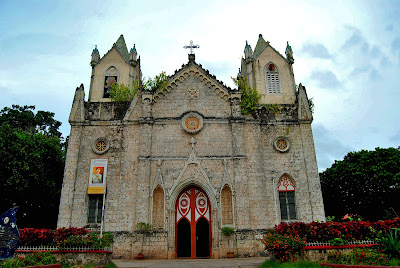The interiors of the church is richly accentuated by a retablo in Rococo design with gilded moldings. The four-sided altars have similar elaborate ornamental designs. The church has a barrel ceiling painted with biblical scenes and personalities.
The construction of this baroque-rococo church of St. Michael de Archangel in the municipality of Argao, started in 1734 and was
completed 1738. It has a resemblance to the church of Dalaguete which I
have mentioned ealier.
The
facade is not as simple as the first church in this blog but it is
carved elaborately with cherubs and ornamental plants. Right above the
main entrance is the Spanish royal seal, an indication
that this church like many other churches in the country was built from the funds of the Spanish monarchy. Flowers and cherubim also decorate the facade and the side entrances.
The church of Immaculate Conception in the municipality of Oslob has survived three fire incidents in the years 1942, 1955 and the last was in the year 2008 and later parts which were affected by the fire. What was left was the belfry and the main building of the church, the coral stones used for the belfry and the walls were quarried from the seas, cut and polished and placed on top of each other and cemented with ashes of seashells. The construction began in 1830 and was finished in 1848.
The last church I had visited was the Church of Patrocinio de Maria in the municipality of Boljoon. This is the view of the chuch from the south bend and the Ili Rock, a natural watch tower located at the end of the municipality.
The church was built in the 18th century by the Augustinian friars, the church and convent still uses clay roof tiles for its roof. The
complex was a fortress church. With in the complex are; block house at
the front left side of the complex served as a watch tower, a school at
the left rear side built in the 1940′s, series of wall ruins, and an
18th century cemetery. Numerous church artifacts are intact. The ceiling
painting was done by local painters in the 1920′s. The church walls are
made of coral stone. The façade is ornamented with ecclesiastic
symbols.
I know I haven't seen the rest of the heritage churches, I may have visited some of them but I am eager to see more and know their history. I am a Catholic and it is significant for me to learn about the existence of these churches in our country, I am not a religious person but every time I see old churches standing still for centuries showing strength and faith, it makes me feel so small...there is a something that tells me to come, be grateful and praise the holiness of the structure.
Thank you for reading.
Source:Heritage Conservation Society
SIMBAHAN
Cebu Heritage
Official Website of Dalaguete











